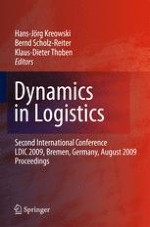2011 | OriginalPaper | Buchkapitel
Adapting Dynamic Logistics Processes and Networks: Advantages Through Regional Logistics Clusters
verfasst von : Ralf Elbert, Hans-Dietrich Haasis, Robert Schönberger, Thomas Landwehr
Erschienen in: Dynamics in Logistics
Verlag: Springer Berlin Heidelberg
Aktivieren Sie unsere intelligente Suche, um passende Fachinhalte oder Patente zu finden.
Wählen Sie Textabschnitte aus um mit Künstlicher Intelligenz passenden Patente zu finden. powered by
Markieren Sie Textabschnitte, um KI-gestützt weitere passende Inhalte zu finden. powered by
